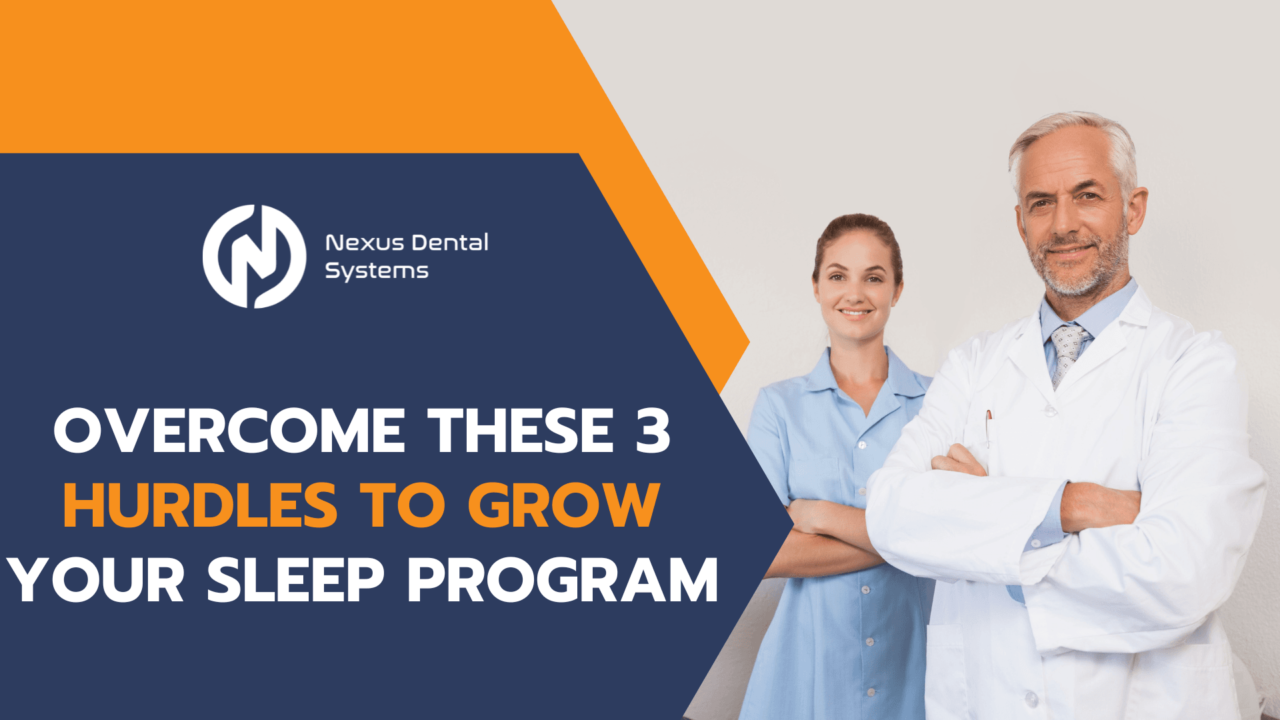You know the need is there; it’s why you decided to add a sleep program to your practice. With 22 million people in the U.S. suffering from obstructive sleep apnea (OSA), there are plenty of patients who can benefit from these services. Yet, you’re still struggling to find them.
The truth is, incorporating a sleep program into a busy dental practice isn’t easy. Many dentists struggle at first, with some giving up before they ever really get started. This is a frustrating scenario, and one that could have been avoided with the proper guidance.
If you’re ready to start a sleep program, or already have one that just isn’t seeing results, it’s important to find the right companies and organizations to partner with. These partners can help you develop and grow that program, and show you how to avoid the common hurdles that hold dentists back. Here, we take a closer look at those hurdles and how Nexus Dental companies can provide the guidance you need to achieve success.
-
Dentists aren’t getting proper training.
There are plenty of training options for dentists interested in treating sleep, from weekend courses to webinars to mini-residencies. The problem is, many of these programs don’t offer the comprehensive training required, so dentists finish unprepared for what awaits. Many even give dentists diplomate status before they’ve ever even treated a case, a practice that hurts the industry as a whole.
Training through the Academy of Clinical Sleep Disorder Disciplines (ACSDD) is different. This non-profit organization offers a rigorous 13 CE course online program. Once dentists complete the coursework and pass the exam, they qualify to submit cases for board review. And that’s how they earn diplomate and fellow status.
The ACSDD is the only organization that offers a fully online, on-demand certificate in Dental Sleep Medicine. Dentists can study lectures and course materials at their own pace and take the exam when they’re ready. By the end of the course, they have both the medical and dental knowledge required to implement a sleep program. They know how to develop a strong network of referring physicians and how to manage medical billing, for example, both of which are crucial to a creating a healthy sleep program.
An accreditation from the ACSDD is the best way to prepare yourself for everything a new sleep program entails. By the end of the course, you’ll have the clinical skills required to identify and screen OSA patients, as well as an understanding of all the business elements that are part of your sleep program.
-
Team members aren’t properly trained.
Often, team members don’t understand why the dentist has decided to incorporate a sleep program into the practice. Many don’t really know what’s expected of them, and are annoyed they have to add more tasks to their already busy days. That’s why education is so critical. Talk to your team members about the dangers associated with sleep apnea and its prevalence. Once they understand how sleep medicine can change, even save, lives, they’ll be excited about offering it to your patients.
But getting your team on board isn’t enough. You must offer them comprehensive training as well. There are new protocols and systems they’ll have to learn, and they should be comfortable with them all. Take screening as an example. If team members aren’t confident they know what to do during a screening, they’ll either make mistakes that slow the process down or they’ll opt to skip the screenings altogether. Both scenarios hurt your sleep program.
As a busy dentist, you don’t have time to go over everything you learned during your training with team members. That’s where N3Sleep comes in. This comprehensive, whole team training program gives team members the confidence and knowledge they need to be successful. N3Sleep works with teams to develop protocols and offers ongoing coaching. And trainers have experience with all the software, tools and systems dentists use for their sleep programs. Integration is simple, making the transition smoother for your team members.
-
Patients aren’t accepting treatment.
Many patients have OSA and don’t know it. Sleep dentists not only have to identify and screen these patients, they also have to get them to accept the treatment they recommend, which includes oral appliance therapy. But if you’re not properly educating patients about the dangers of OSA and the impact it can have if left untreated, they’re not going to move forward with treatment.
DreamSleep creates informative, effective patient outreach materials that can help you attract new patients to your practice for screenings and to provide that much needed education. Outlets include brochures, social medial channels and screening events.
DentalPlay also can help educate, offering a large library of 3D animations of sleep, oral surgery, cosmetic, implant, orthodontic and periodontic procedures. These animations can be streamed to tablets or added to the office video system.
Training through N3Sleep will help you improve your case presentation skills, giving case acceptance numbers a big boost. You’ll learn how to talk to patients about OSA and to present treatment in a way that makes them want to move forward.
The more educated patients are about the dangers of OSA, the more likely they are to be screened and to ultimately accept treatment. Make this a priority in your practice.
The right partners
Incorporating a sleep medicine program into your practice can be challenging, especially if you and your team members aren’t properly prepared. Education and training are crucial to your success. If you partner with the right organizations, such as ACSDD, N3Sleep and DreamSleep, you’ll find you and your team members are more confident in your skills, more knowledgeable about sleep medicine and more comfortable working directly with physicians to provide patients with the best care possible. Patients will benefit, with many finally getting treatment that will give them a better quality of life.

